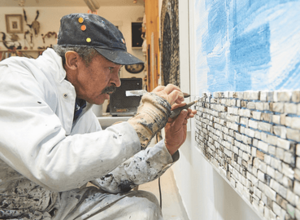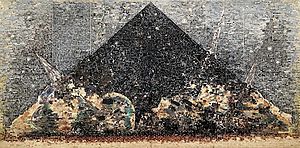Jack Whitten facts for kids
Quick facts for kids
Jack Whitten
|
|
|---|---|
 |
|
| Born | December 5, 1939 |
| Died | January 20, 2018 (aged 78) |
| Nationality | American |
| Known for | Abstract painting |
| Awards | National Medal of Arts |
Jack Whitten (December 5, 1939 – January 20, 2018) was an important American painter and sculptor. He was known for his unique abstract art. In 2016, he received the National Medal of Arts, a very high honor for artists in the United States.
Contents
Jack Whitten's Early Life
Whitten was born in 1939 in Bessemer, Alabama. When he was young, he planned to become an army doctor. He studied pre-medical subjects at Tuskegee Institute from 1957 to 1959.
While studying, he visited Montgomery, Alabama. There, he heard Martin Luther King Jr. speak during the Montgomery Bus Boycott. This experience deeply inspired Whitten. He was moved by King's ideas for a better America.
In 1960, Whitten went to Southern University in Baton Rouge, Louisiana. He began studying art there. He also became involved in Civil Rights demonstrations. Whitten even helped make the signs and slogans for a march to the state capitol.
Whitten strongly believed in Martin Luther King Jr.'s peaceful approach. However, he saw violent reactions from people who supported segregation. This made him realize he needed to leave the South. He felt that staying would make him angry and violent too. So, in 1960, he moved to New York City.
He quickly enrolled at the Cooper Union art school. He graduated in 1964 with a degree in fine art. After that, he stayed in New York as an artist. He was greatly influenced by abstract artists like Willem de Kooning and Romare Bearden.
Jack Whitten's Art Style
After graduating, Whitten met other Black artists in New York City. These included famous artists like Jacob Lawrence and Norman Lewis.
Whitten's art was known as abstract. This means it didn't show real-life things exactly as they look. Instead, it used shapes, colors, and textures to express ideas. Whitten liked to say his art had "truth and soul."
Many of Whitten's paintings were inspired by his experiences during the Civil Rights Movement. He believed that slavery had harmed the culture of Black people. Whitten felt it was his job to help bring that culture back through his art.
Whitten started painting in the 1960s. He developed unique techniques. For example, he would place a nylon mesh fabric over his wet acrylic paintings. This created a soft, feathery effect.
He also used a special T-shaped tool he called the "developer." He would move this tool across his art in one smooth motion. This technique showed how different points could be connected.
Black Monolith Series
One of Whitten's most famous works is his Black Monolith Series. Most paintings in this series were tributes to important Black activists, politicians, and artists.
Two well-known works from this series are:
- Black Monolith III for Barbara Jordan, 1998
- Black Monolith II for Ralph Ellison, 1994 (Ralph Ellison wrote the famous book Invisible Man).
Exhibitions and Recognition
Whitten's art was shown in many important places. In 1972, his work was featured at the Annual Exhibition of Contemporary American Painting at the Whitney Museum of American Art. The Whitney Museum even had a solo show of his paintings in 1974.
He also had individual shows at many galleries and universities. These included a 10-year look back at his work in 1983 at the Studio Museum in Harlem. In 2008, he had an exhibition of memorial paintings at the Atlanta Contemporary Art Center in Atlanta, Georgia.
Whitten often spent summers in Crete, where he had a studio. There, he created sculptures.
Throughout his career, Whitten explored different painting techniques and materials. He also thought about how art connects to its inspirations. Sometimes, he used quick, brushstroke-like methods. Other times, his work showed careful, planned construction. The The New York Times newspaper called him the father of a "new abstraction."

After the 9/11 terrorist attacks on the World Trade Center, Whitten was at his studio nearby. In the years that followed, he created a huge painting as a memorial. He even put ashes from the attacks into the artwork.
In 2015, President Barack Obama gave Whitten the National Medal of Arts. This award recognized his amazing contributions to American art.
Major Art Exhibitions
In 2013, an exhibition called Light Years: Jack Whitten, 1971-73 was organized. It showed many of Whitten's works from those years that had never been seen before.
In 2014, a large exhibition looking back at his career was organized by The Museum of Contemporary Art in San Diego. This exhibition traveled to other museums, including the Wexner Center for the Arts in 2015. It also went to the Walker Art Center in Minneapolis from September 2015 to January 2016.
In 2018, an exhibition called "Odyssey: Jack Whitten Sculpture 1963–2016" opened. It showed his sculptures and opened around the time he passed away. This exhibition was at the Baltimore Museum of Art. It then traveled to the Metropolitan Museum of Art in New York and the Museum of Fine Arts, Houston. In 2019, his first solo exhibition in a European museum was shown in Berlin.
Personal Life
Jack Whitten passed away on January 20, 2018, at the age of 78. He and his wife, Mary, lived in Queens, New York.

